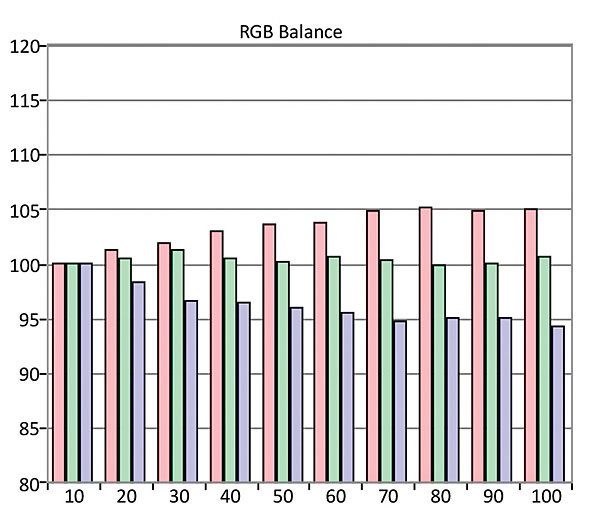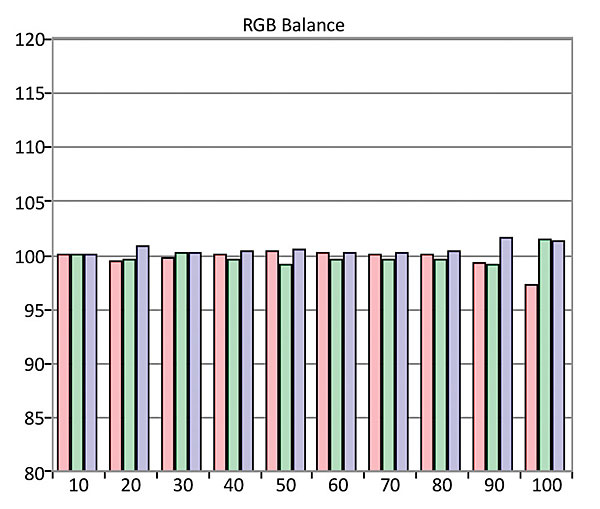LG OLED65E7P OLED Ultra HDTV Review Test Bench
Measurements were made with SpectraCal CalMAN software with Photo Research PR-650 and Klein K-10A color meters and the AVFoundry VideoForge (HD) and Murideo Fresco 6-G (UHD) pattern generators. The peak white levels given below were rounded here to the nearest foot-lambert/nit.
Standard Dynamic Range (1080p) Full-On/Full-Off Contrast Ratio: Unmeasurable
With the peak white output set to 46 ft-L (159 nits), post-calibration in the ISF Expert (Dark Room) picture mode, with OLED Light at 45, Contrast at 85, and Brightness at 50, the black level could not be measured. Effectively, it was totally black, making the full-on/full-off contrast ratio, at best, infinite—or, practically speaking, unmeasurable.
In SDR and the ISF Expert (Dark Room) picture mode, the pre-calibration grayscale Delta E values ranged from 1.06 at 20% brightness to 3.21 at 100%—the latter the only value above 2.45. Post-calibration (using only the 2-step White Balance adjustments), the values ranged from 0.067 at 20% to a high of 1.9 at 100%.


The pre-calibration SDR color Delta E values ranged from 1.42 in yellow to 2.77 in red. After calibration, the minimum was 0.74 in magenta and the maximum 1.39 in blue. The average gamma, with the set’s Gamma control on BT.1886, was 2.47. The latter is a little higher than desirable. Some material looked a little dark (a characteristic of high gamma). When this occurred, I changed the Gamma control to 2.2 (and on some material also dropped the Brightness control by one or two steps). If desired, the 20-step White Balance controls (not used here) offer white luminance controls at each step that can tweak the gamma. Significantly, the 20-step controls for HDR do not offer this feature; it would have been useful, since the Gamma for HDR is much more tightly specified, and the set’s HDR gamma is otherwise fixed and not adjustable.
(Delta E is a figure of merit that indicates how closely a display adheres to the color standard. Experts generally agree that at levels below 3 to 4, the result is visibly indistinguishable from perfect color tracking.) High Dynamic Range (HDR10) at 4K (3840 x 2160) Resolution
Full-On/Full-Off Contrast Ratio: Unmeasurable
At the set’s peak measured HDR white output of 651 nits (190 ft-L), post-calibration in the Cinema (User) HDR10 picture mode, with OLED Light at 100, Contrast at 100, Brightness at 50, and Dynamic Contrast on Medium, the black level, as in SDR, could not be measured.

The pre-calibration grayscale Delta E values ranged from 0.4 to 8.3. Post-calibration, the values ranged from 0.1 to 7.7. These high values might appear alarming, but for HDR the Delta E values include the x/y coordinates of the white point and the luminance at the same level. Since it wasn’t possible to tweak the white luminance to fine-tune the gamma (for HDR, the gamma is now called the EOTF, for Electro Optical Transfer Function, and the specified EOTF is known as the Perceptual Quantization, or PQ, curve), high luminance at some values resulted in high Delta Es. See our online Test Bench at soundandvison.com for additional details.
P3 and BT.2020 are the two color gamuts of current interest for Ultra HD. The tools for measuring how well a display can reproduce these gamuts at different luminance levels (the so-called color volume) are still limited. But those tools indicated that while the LG was restricted in its ability to achieve BT.2020 at high luminance, the results with P3, while not perfect, were very good. No UHD consumer source we know of as yet goes beyond P3.—TJN


























































